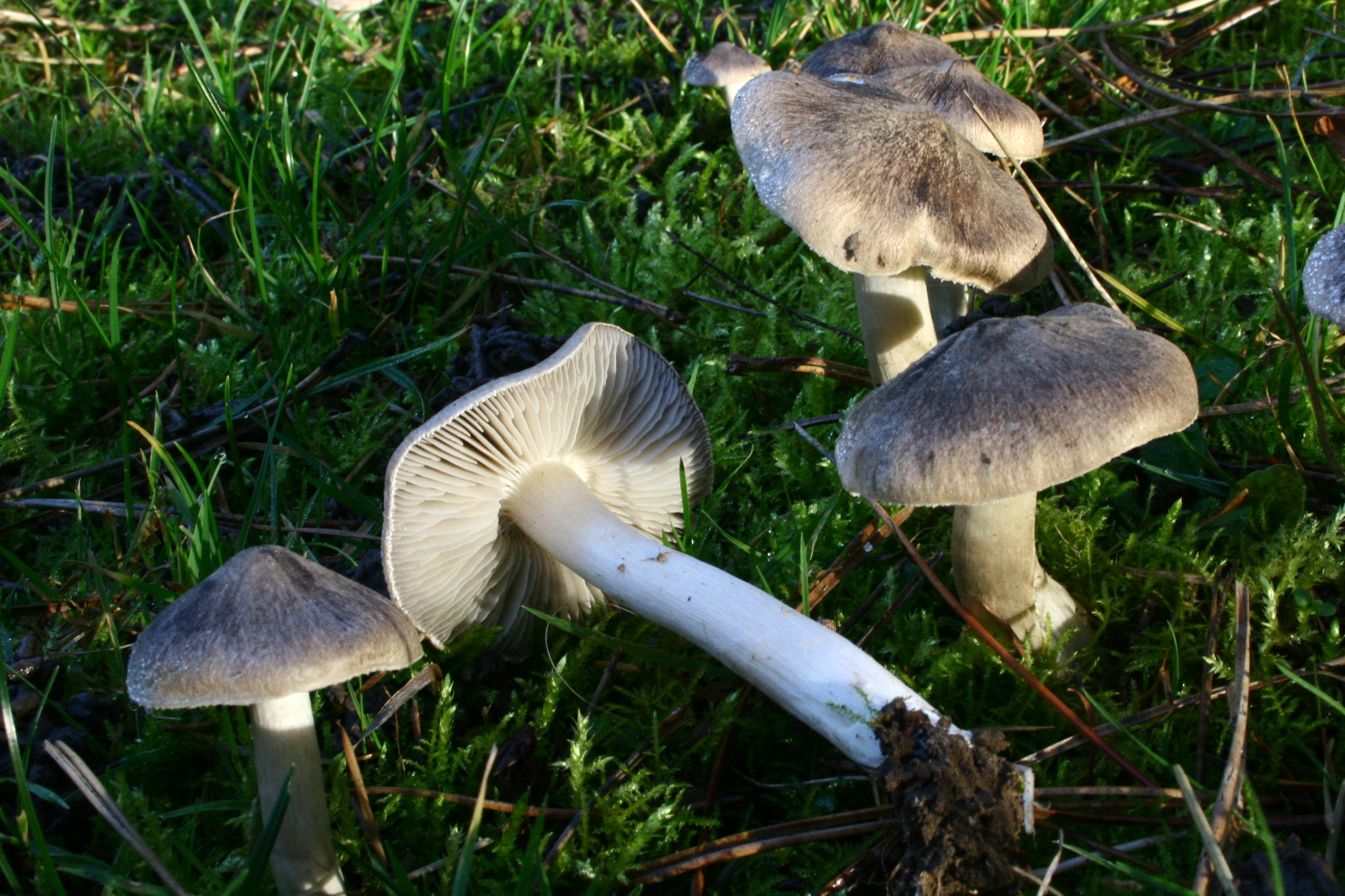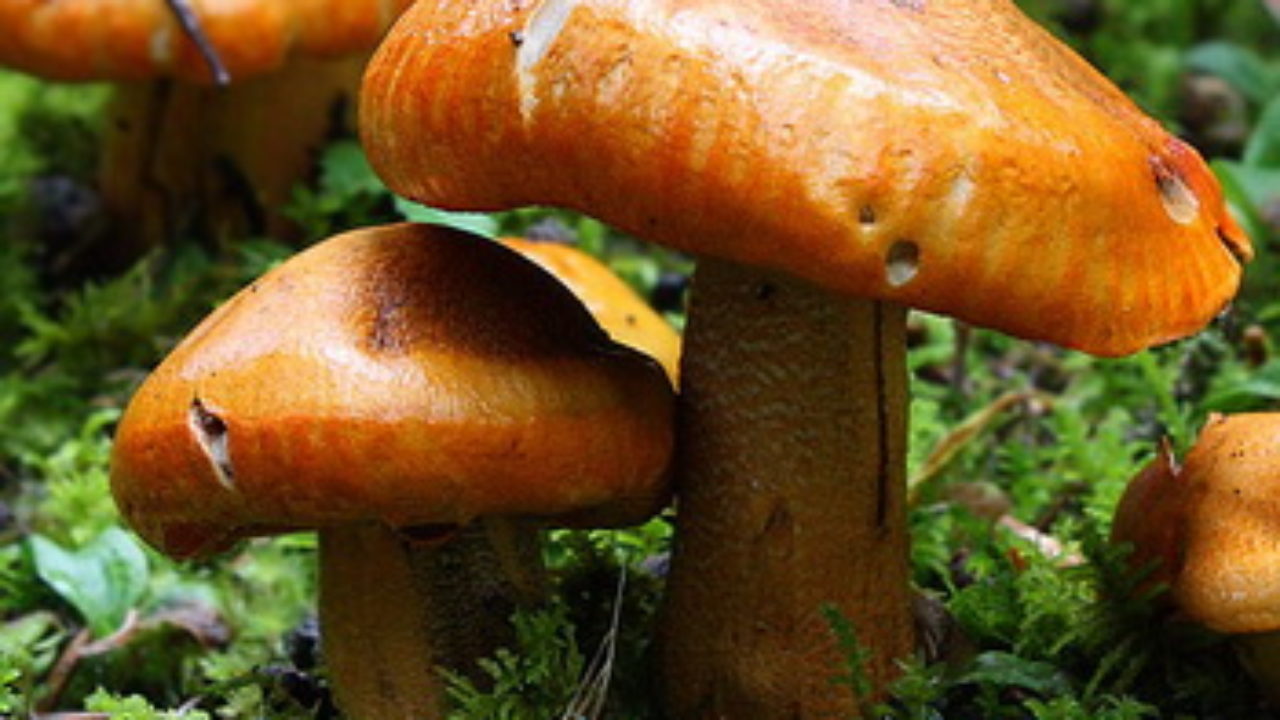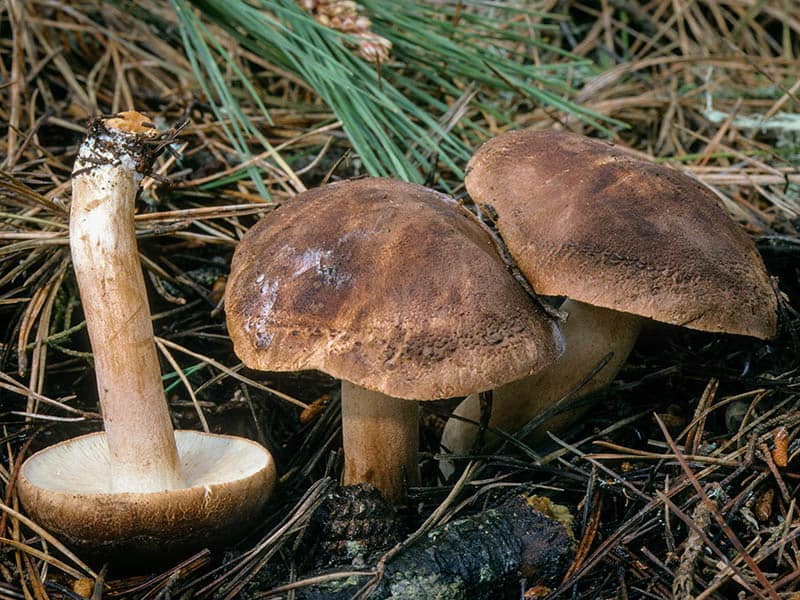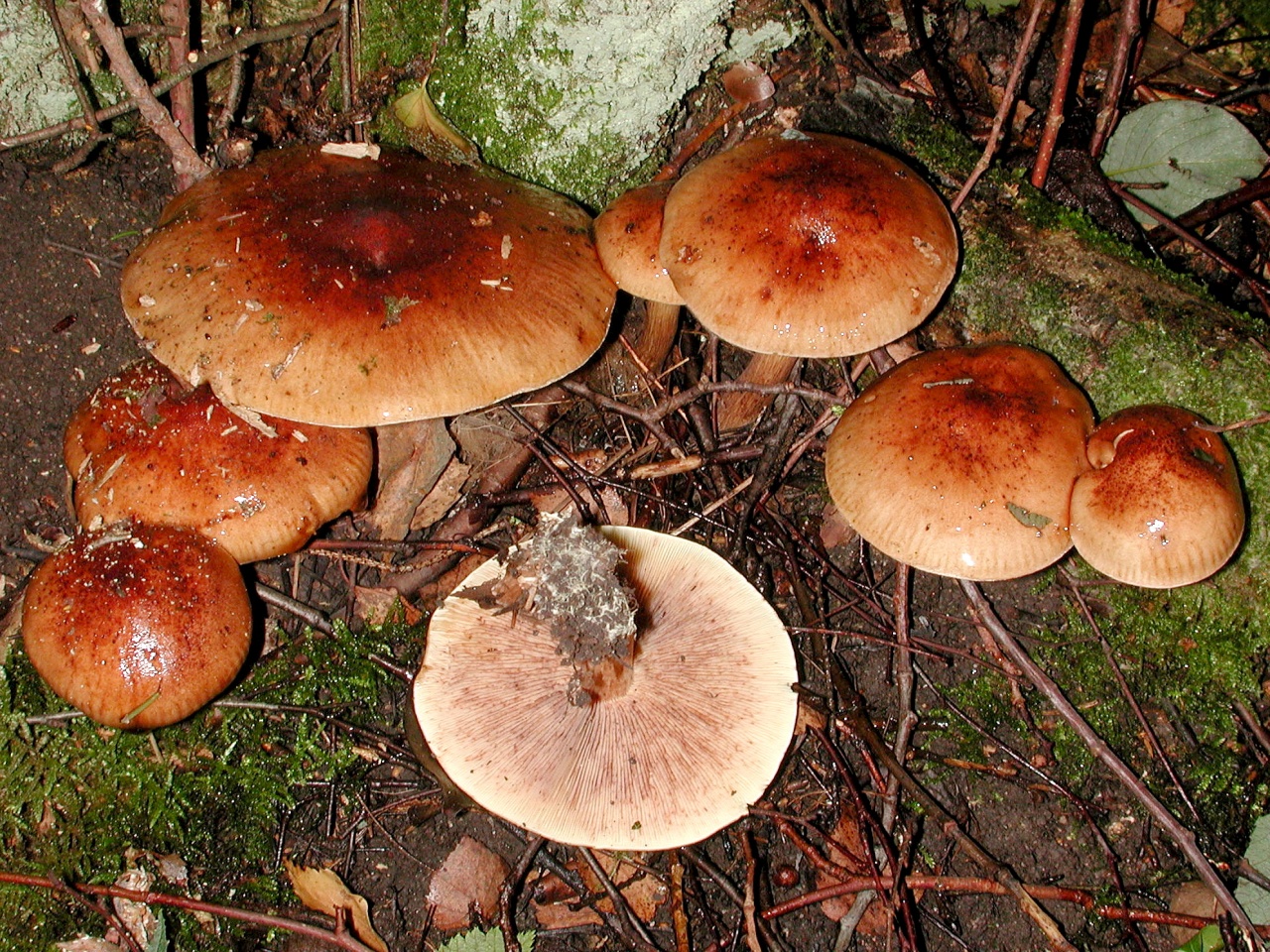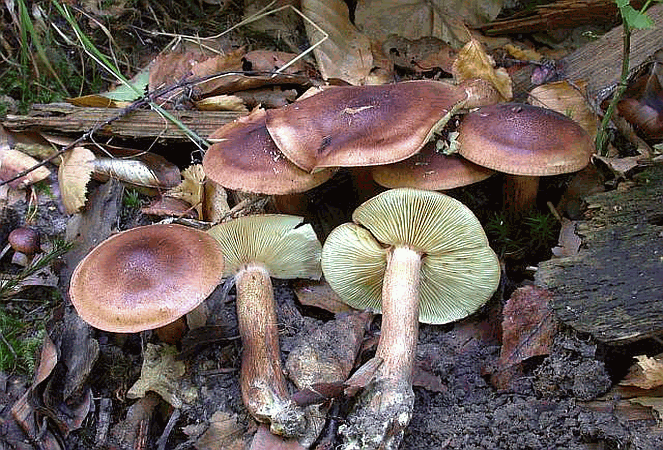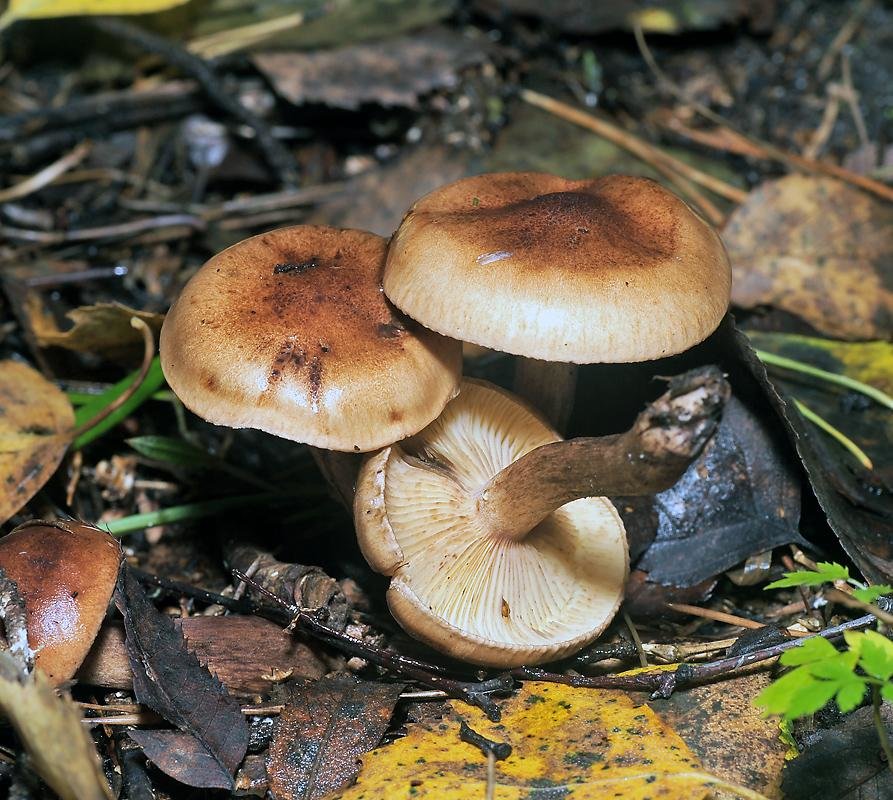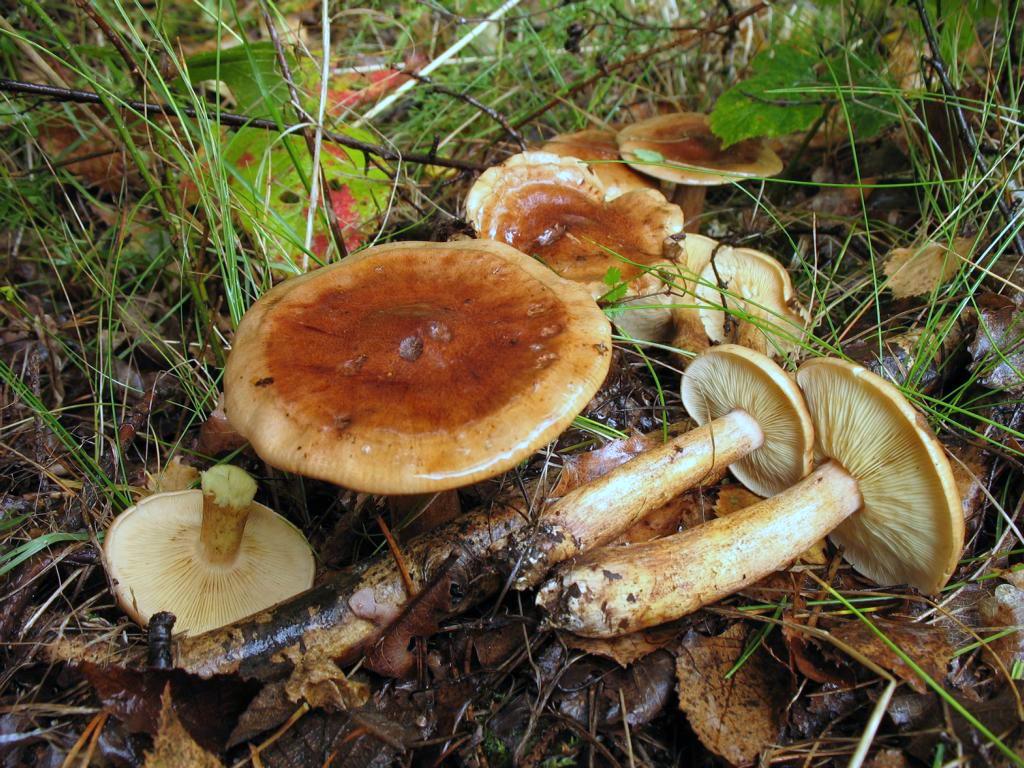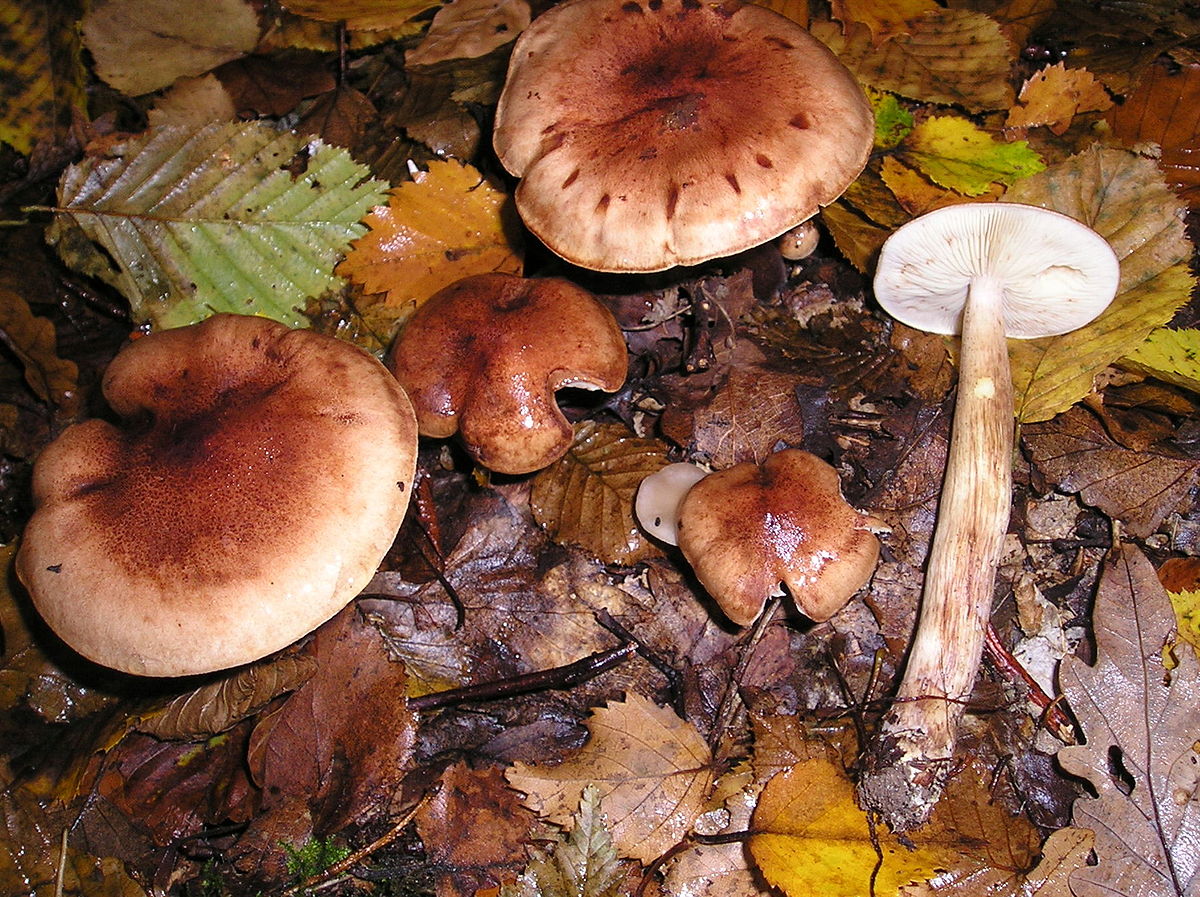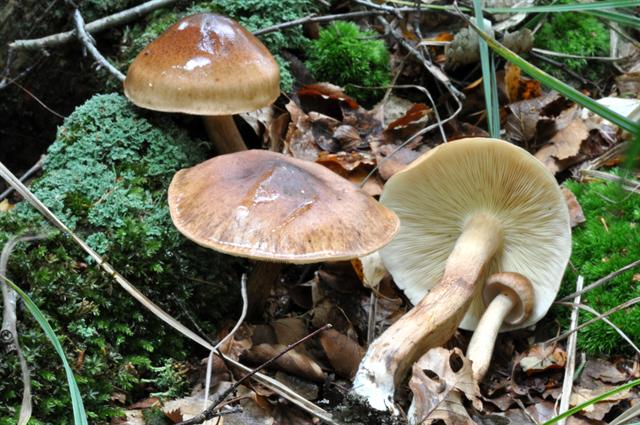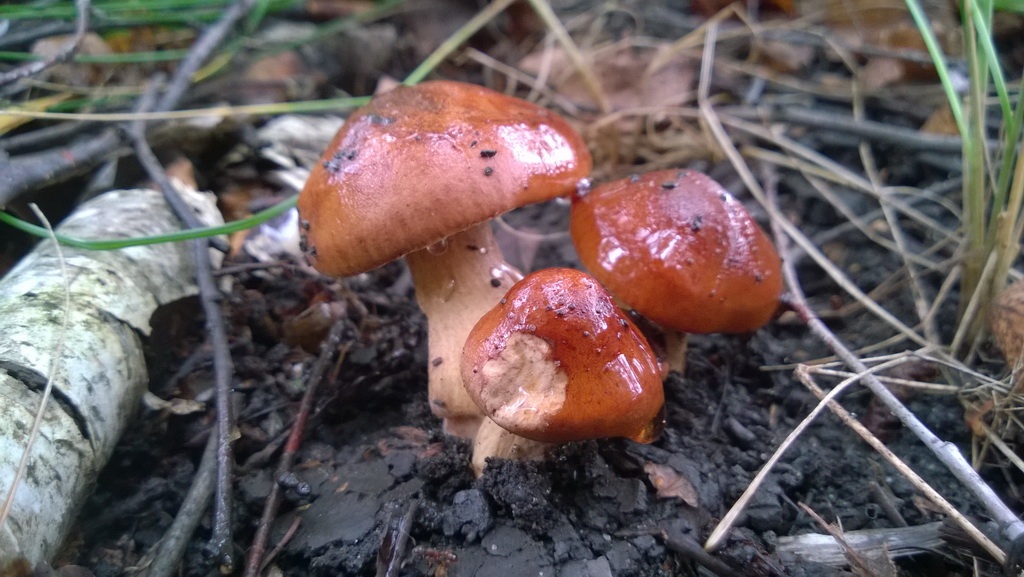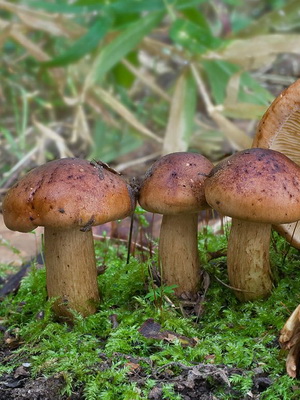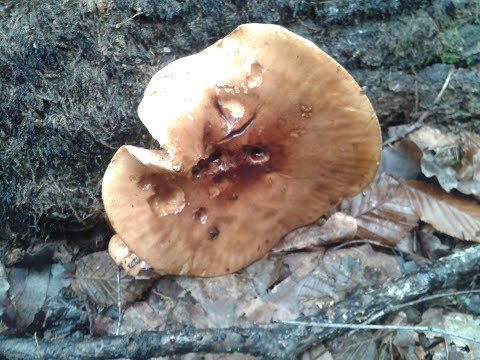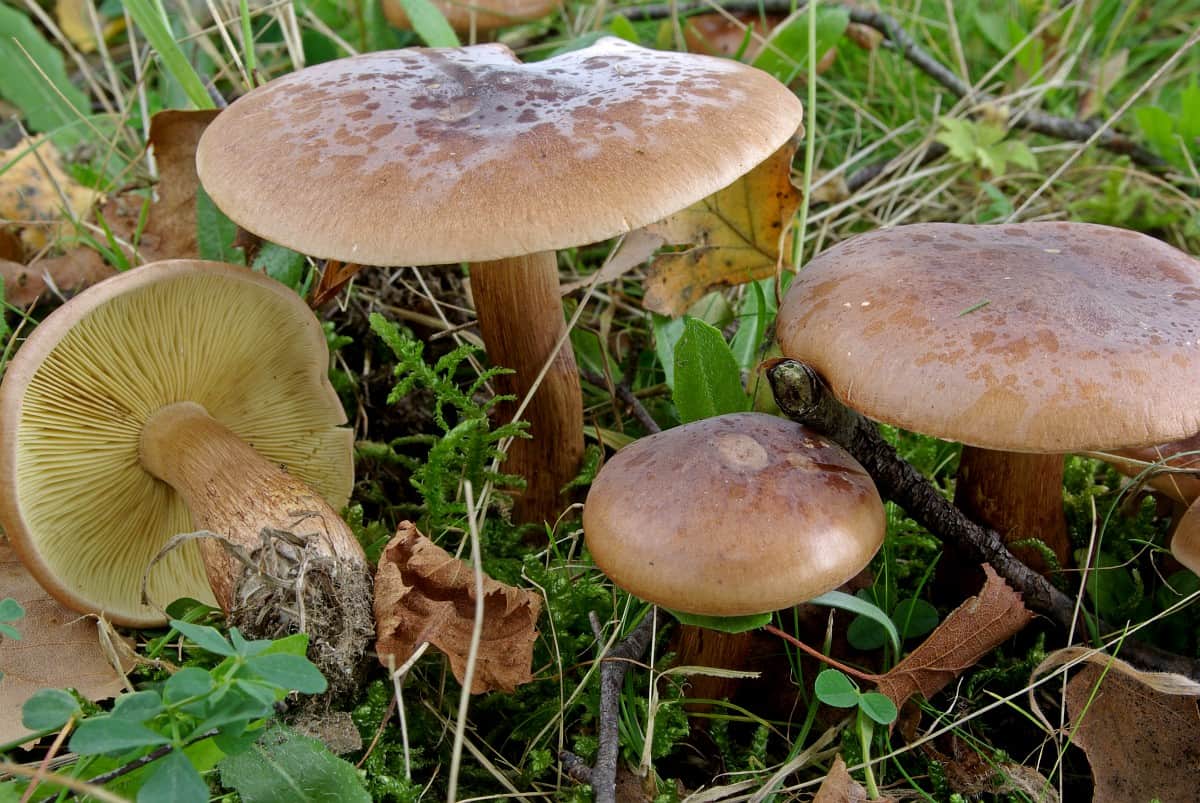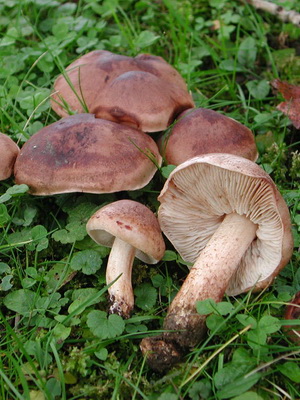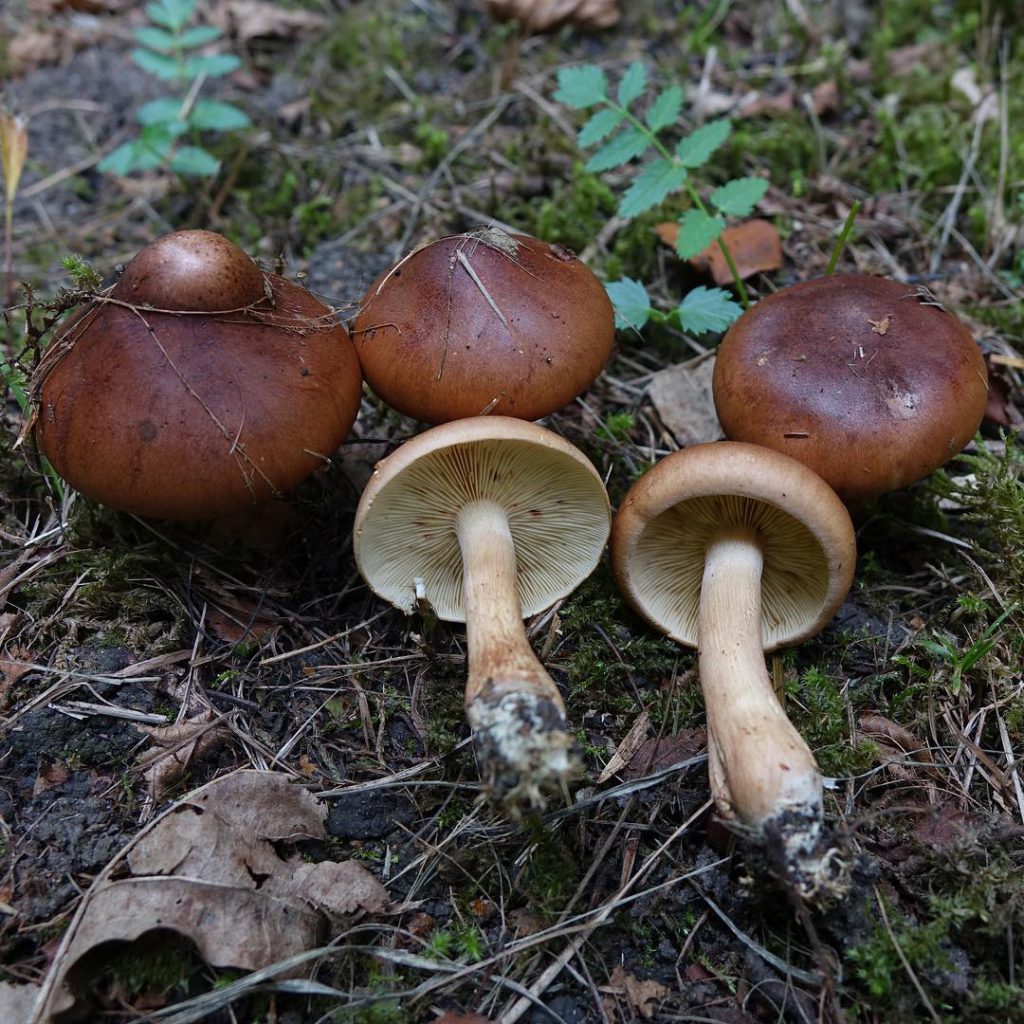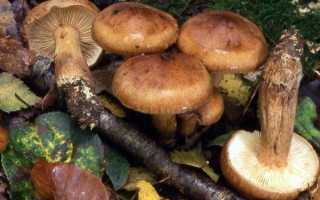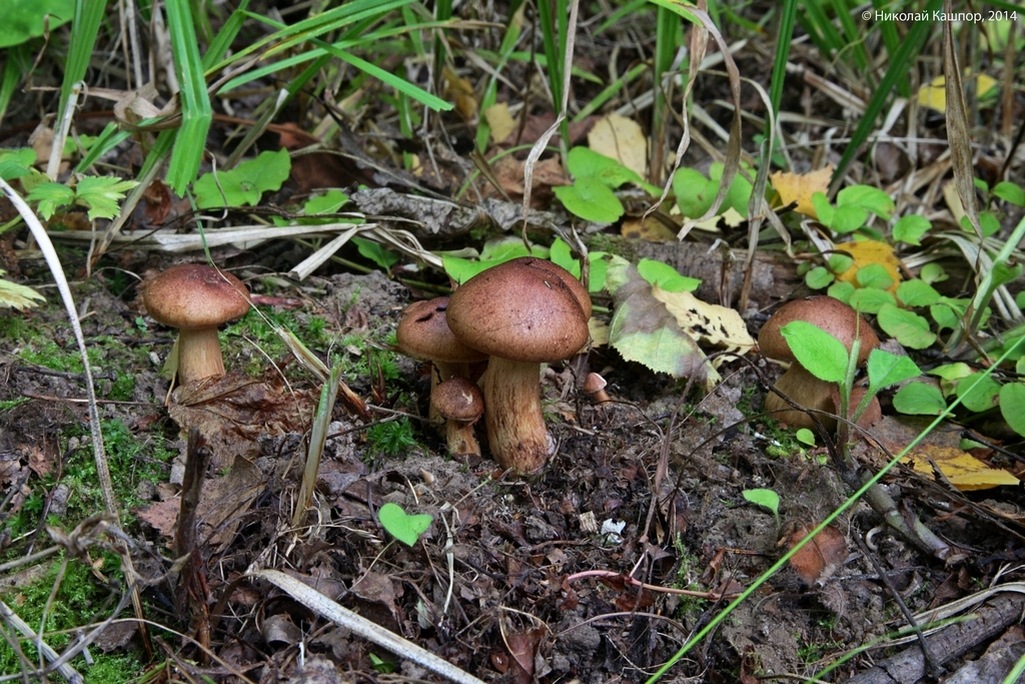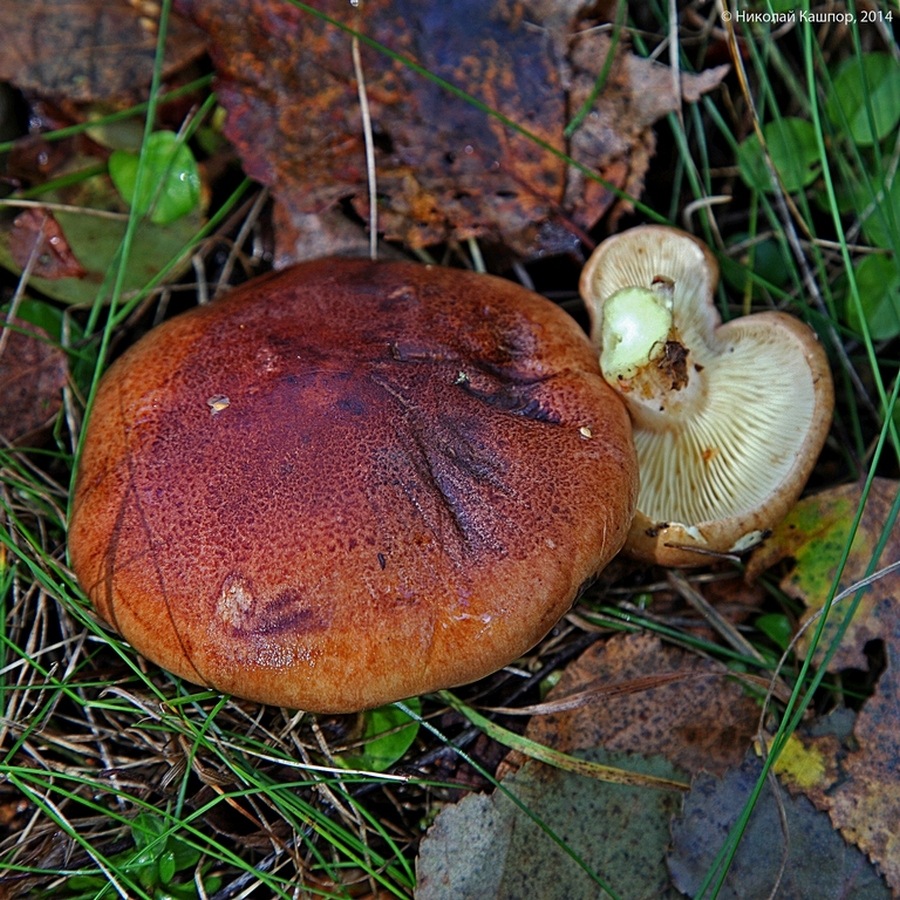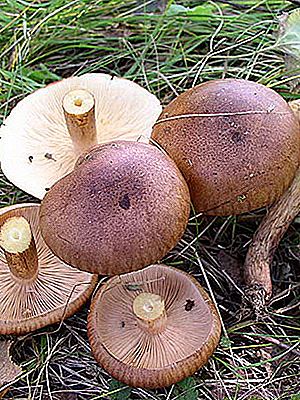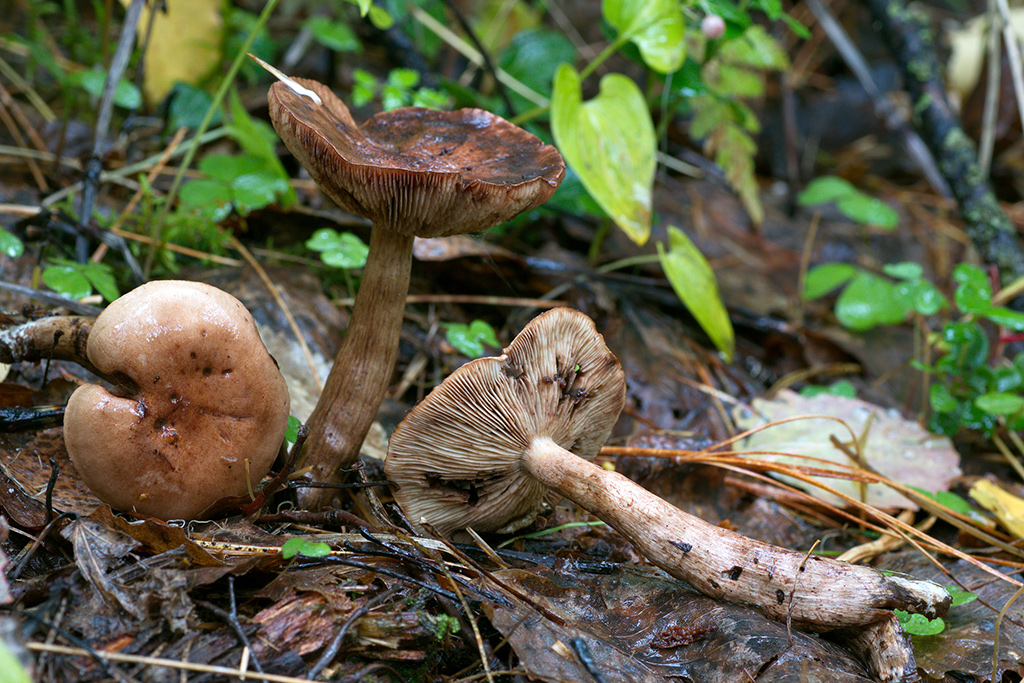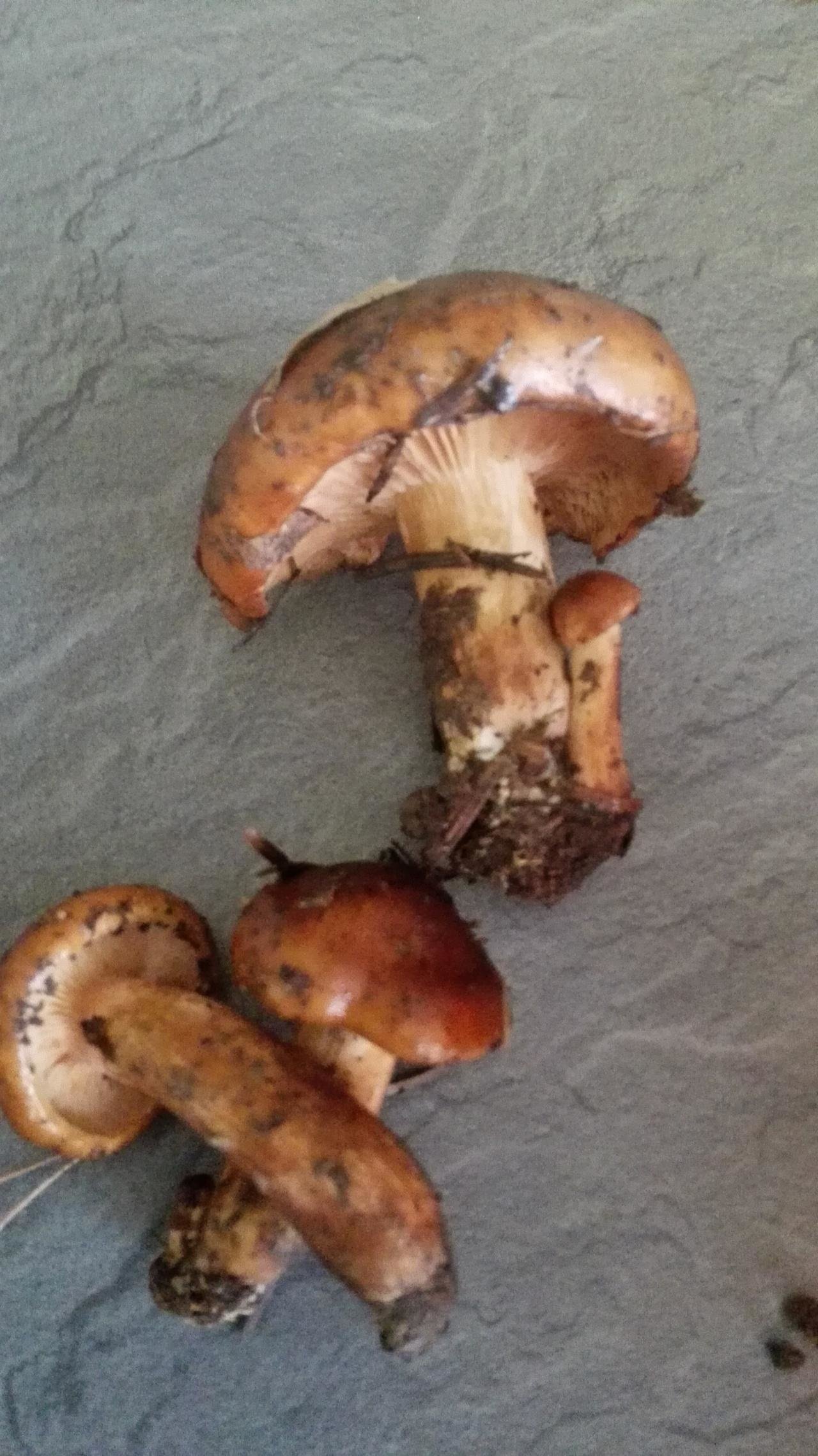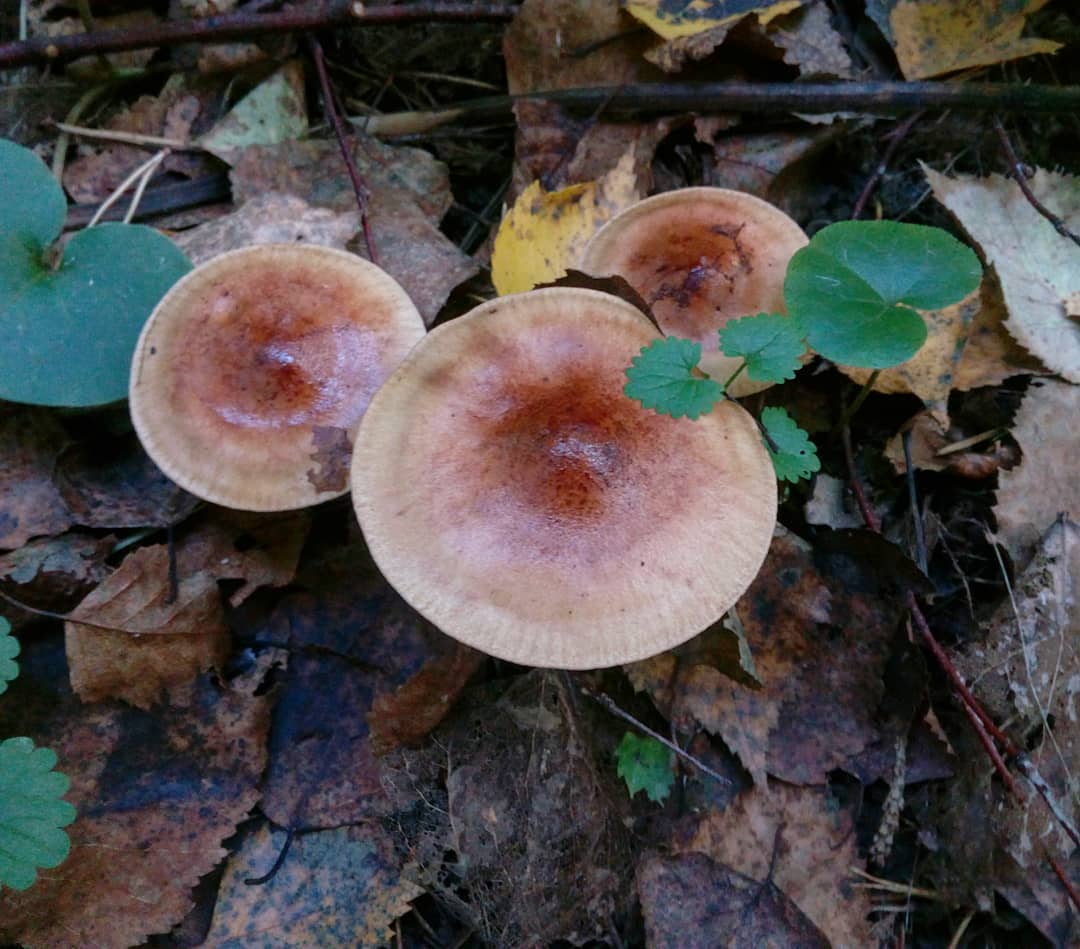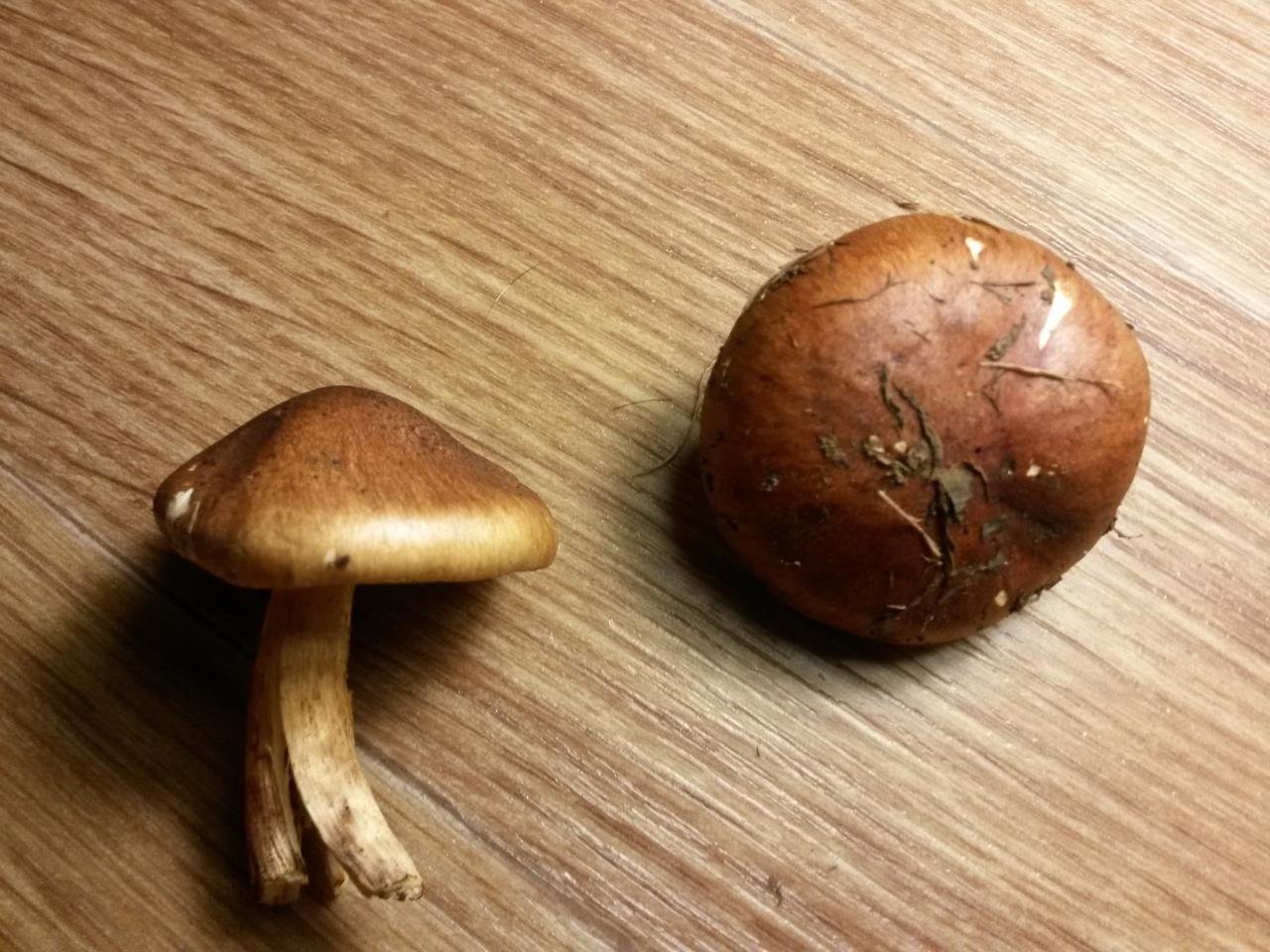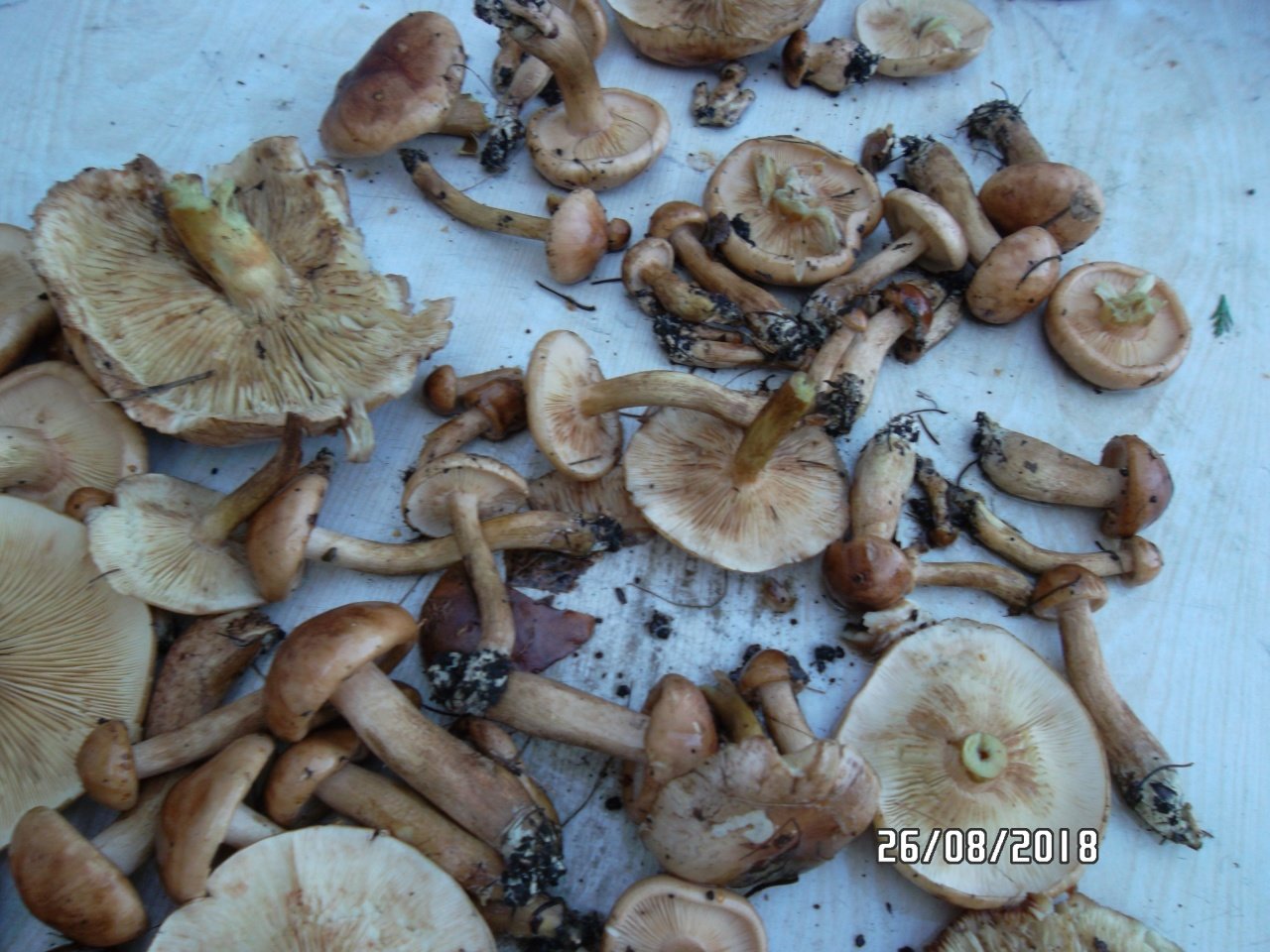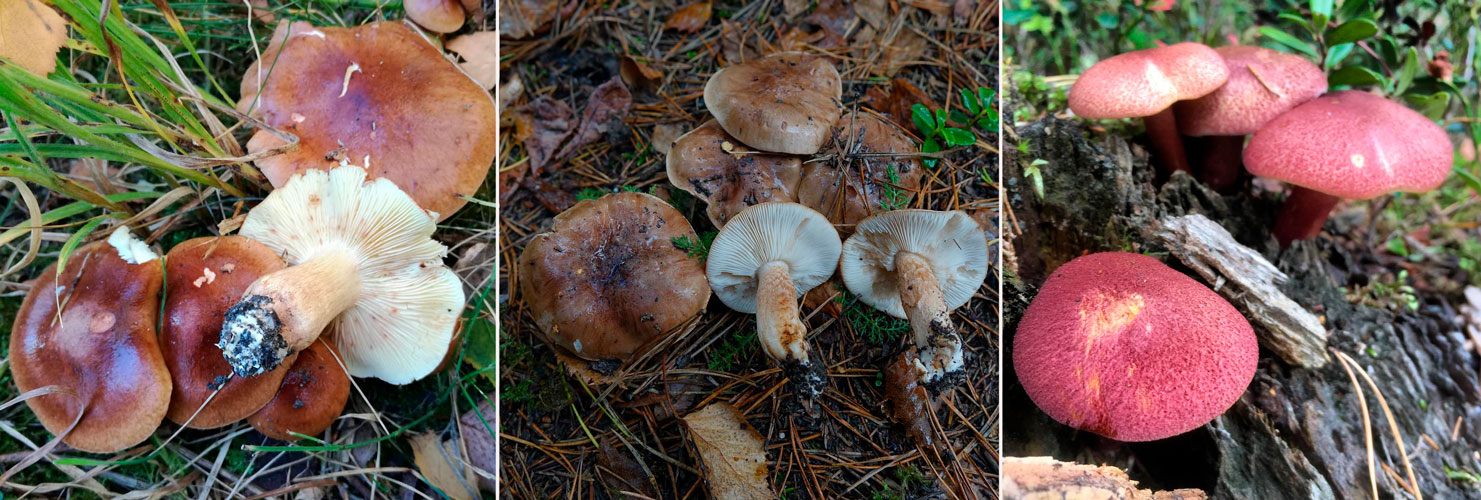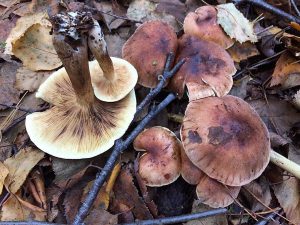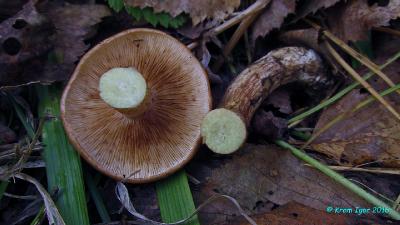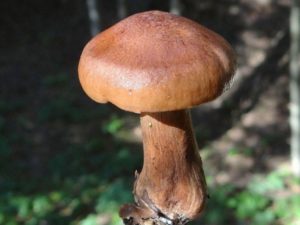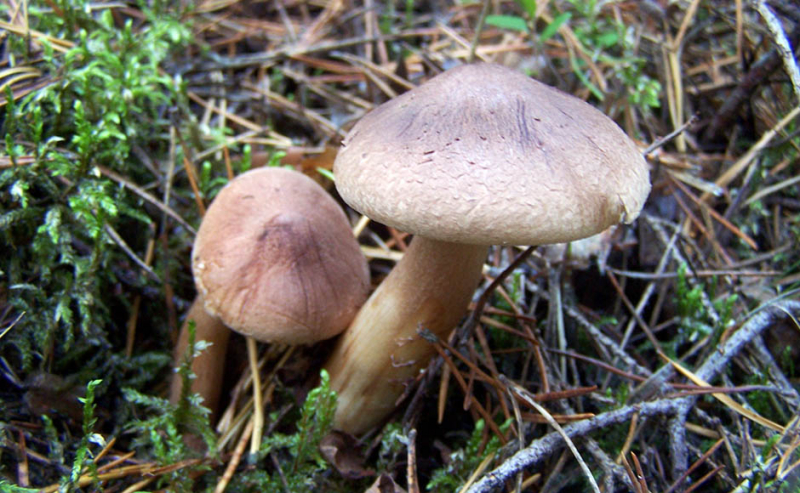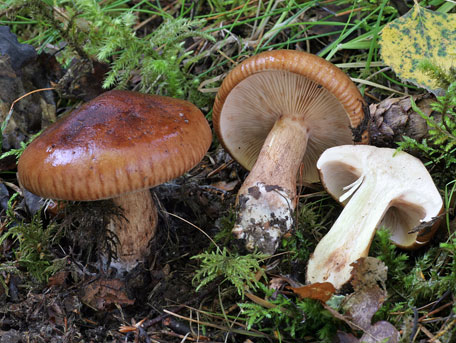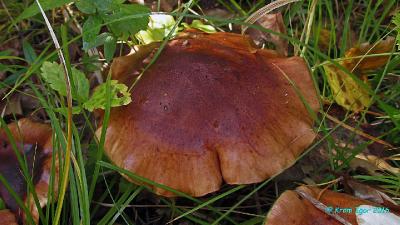Description of the mushroom
The bandaged ryadovka, or red ryadovka, is a member of the family Tricholomotaceae of the genus ryadovka (Tricholoma). Popularly known as the skull.
Latin name Tricholoma focale, scientific synonyms: Tricholoma zelleri, Armillaria zelleri.
Hat with a diameter of up to 12-15 cm, medium fleshiness. Young mushrooms have a convex shape, sticky, yellowish color. Over time, it becomes widespread, dry, with a wavy edge drooping down. The color ranges from scarlet to reddish brown with dark radial stripes. In the center of the cap, scales are sometimes visible on the tubercle.
The hymenophore (the so-called lower part of the cap with a spore-bearing layer) consists of plates adhered to the stem with a tooth. They are located often or rarely, changing color from white and cream to grayish or pale yellow. With age, they become covered with dark brown spots, especially closer to the edges. In young specimens, the plates are hidden under a fibrous sheath (blanket), which disintegrates during growth. The flesh on the cut is dense, thick, white, under the skin it is reddish. Tasteless or slightly bitter, with a faint smell of fresh flour. Spores are wide, elliptical, white powder.
The leg is 4–11 cm long, in some specimens it is 14 cm, up to 4 cm in diameter. Straight, fusiform or tapering towards the base, sometimes curved. In the upper part of the leg there is a fibrous reddish ring, above which the surface is smooth or with a slight whitish flocculent bloom. Under the ring - the color of the cap, in soft felt red-brown scales. Young mushrooms have dense legs, old ones have longitudinal fibers and are hollow.
A bit of history
The mushroom was first described in 1838 by the Swede Elias Magnus Fries. In 1879, the German mycologist Adalbert Ricken gave the species the name Tricholoma focale adopted by modern taxonomy.
Application
Ryadovka mushrooms are widely used in cooking and medicine. But before using the fruiting bodies for medicinal purposes, be sure to consult with your doctor.
In cooking
Edible varieties of ryadovka mushrooms taste bitter if not properly processed. It provides for soaking in cold water for several days. At the same time, water is regularly (2-3 times a day) drained and new is poured. Then the fruit bodies are boiled in salted water for 20 minutes. As a result, the bitterness goes away.
Popular processing methods:
- pickling for snacks;
- pickling;
- canning for the winter;
- some types are fried after boiling.
Drying ryadovka mushrooms is impractical: the pulp will be bitter and tough without processing, therefore it is not suitable for food. Fresh fruit bodies are stored in the refrigerator for up to 3 days, salted ones - up to 3 months. Rows are stored for the longest time without loss of quality and harm to health in deep freeze and canned with sterilization - up to 1 year.
In medicine
In ryadovka, the beneficial properties are not limited to attractive taste and the presence of a significant amount of trace elements and vitamins in the pulp. The benefit of the genus for medicine lies in the possibility of using them to obtain antibiotics in the near future. So, in the pulp of matsutake (a row of shod, or spotted) substances were found, from which antibiotics and antineoplastic substances will soon begin to be obtained.
Contraindications
- people with diseases of the stomach and gastrointestinal tract;
- To old people;
- children under 7 years old;
- people with allergies or individual intolerance;
- The mycelium is planted in autumn at temperatures below + 15 ℃.
- For better aeration, mushrooms need order.
- To create the necessary conditions, the beds are sheltered from the sun and rain.
- When new mycelium forms, add soil.
- After each harvest, it is necessary to add fresh soil.
Conclusion
There are edible and inedible mushrooms. Sometimes it is difficult to establish the belonging of a fungus to a particular species due to the external similarity of several species. If the mushroom picker is not sure about the quality or belonging to one of the edible species, he should not risk his health. Matsutake, which grows in the eastern regions of Russia, is considered a delicacy.
False doubles Rows brown
Some related species of rowers are so similar to sweetmeat that only microscopic analysis allows you to see the differences. The table shows the characteristics of similar species.
| Double name | Hat | LPs | Pulp | Leg | Where is found | Food category |
| Row white-brown (Tricholoma albobrunneum) | With a diameter of 3-10 cm, in young mushrooms it is wine-brown with dark veins, in old ones it is red-brown. The skin is cracked to small scales, shiny. In wet weather - mucous. | Frequent, adherent to the stem, white, pinkish-brown, in mature mushrooms - with reddish-brown spots. | White, dense, under the skin - with reddish veins. The smell of flour or is absent. Mealy, bitter taste | Length 3-10 cm, thickness up to 2 cm, cylindrical or slightly thinned downwards. | In coniferous and mixed forests on poor soils. Forms mycorrhiza with pine. | Conditionally edible mushroom |
| Row yellow-brown (Tricholoma fulvum) | 3-15 cm in diameter, yellow-brown, smooth, without scales. In rainy weather, brilliant | Notched-adherent, wide, frequent or sparse. Cream to light yellow, brown with age with dark spots | Dense, with a bitter odor | 12-15 cm long, 0.5-2 cm thick, cylindrical or widened towards the base, fibrous, rigid. White at the top, cap colors at the bottom | In deciduous and mixed forests. Forms mycorrhiza with birch | |
| Tied row (Tricholoma focale) | Diameter 5-10 cm, bright, with copper shades. The surface is fibrous-scaly, the edges are omitted | Frequent, teeth adhered to the peduncle, white or yellowish | White, dense, firm, reddish under the skin. There is no smell or a weak flour. Tasteless or bitter | 4-10 cm long, up to 3 cm thick, straight or fusiform, sometimes thinning downwards. In young mushrooms, dense, hard, in old ones, hollow, longitudinally fibrous | In pine forests on sandy soils | |
| Cow's row (Tricholoma vaccinum) | 3-8 cm in diameter, red-brown, with tousled fringes around the edges, large scaly | Rare, white or yellowish | White or yellowish, bitter | Length 5-9 cm, thickness 1-1.5 cm, straight, white top, bottom - cap colors | In spruce forests, sometimes in pine forests, rarely in mixed |
To better understand the difference between mushrooms, take a look at the photo. There is no information about dangerous false doubles
There is no information about dangerous false doubles.
Description
Due to its inherent bitter taste, the ryadovka is scaly (Tricholoma imbricatum), it is also sweet, the ryadovka is brown, the ryadovka is brownish, the ryadovka is fibrous-scaly, belongs to the category of conditionally edible mushrooms.
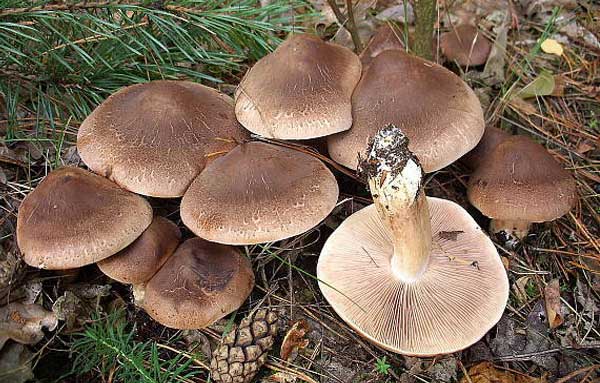
Differs in the following species characteristics:
- The initial rounded-bell-shaped cap with curled edges later becomes convex and plano-convex, with small scales in the central part, which retains a wide tubercle, the surface is dull and dry. The color is dark brown, in mature mushrooms it brightens somewhat along the edge. The diameter of the cap can be up to 10 cm (minimum - 3 cm).
- wide, often located plates often grow to the pedicle with a tooth or sabot. At first they are very light, later they become creamy, then darken to brownish, in places reddish-brown spots appear on them;
- white spores;
- fibrous cylindrical stem, often curved; with age, cavities are formed in it. The light color of the upper part, as it moves to the base, is replaced by brown with a yellowish or pinkish tint. Maximum dimensions - 2 cm thick, 10 cm long;
- light, white or creamy, firm flesh has a faint smell of fruit and a mealy taste, more or less bitter.
Primary processing and preparation
Ryadovka yellow-brown is considered a conditionally edible representative of the mushroom kingdom and belongs to category IV. Those who have tried it say that it is not tasty and very bitter. This is probably why she is not popular with mushroom pickers. But if you know the secrets of its preparation, then the ryadovka will turn out to be quite a tasty addition to your table.
The yellow-brown ryadovka is harvested only at a young age, while the fruiting bodies are not yet very bitter. It is usually salted or pickled along with other types of mushrooms. It can also be boiled or fried, but after a preliminary 40 minute boiling and draining the water in which the rows were located.
The yellow-brown ryadovka is a seemingly completely unremarkable mushroom, but it will grow even when the year is dry and there are no mushrooms in the forest. This is probably why it is still sometimes collected. But in the mushroom year, most often this row is simply bypassed, giving preference to other representatives of the mushroom kingdom.
Appearance and habitat
The ryadovka or govorushka mushroom forms fruiting bodies with a distinct division into a cap and a leg. In representatives of the genus, the cap is flat (this is characteristic of mature mushrooms, but in young ones it is hemispherical), with lamellar hymenoforms, it differs in color in different species. The leg is long, cylindrical in shape.
Rows are ground types of mushrooms. Most often, the mycelium chooses the soil next to conifers. Individuals grow in heap in small groups. They can form ring colonies - "witch circles". There are many places where ryadovki grow: they are forest, meadow, grow in groves and even parks.
Geographically, the types of rows cover the whole of Russia. The species also grows in the Crimea. Crimean mushrooms are actively harvested from early spring to mid-winter due to the warm climate. Basically, the time of fruiting of the genus is autumn, because it is the autumn fruiting bodies that reach their peak of fleshiness and quantity. Some species appear in the spring, while others bear fruit until cold weather. The ryadovka mushroom combines many types, a description of which will be useful to every mushroom picker, so as not to send false mushrooms to the basket, and then to the plate.
Beneficial features

Representatives of different species belonging to the Ryadovka genus contain vitamins A, group B, PP, E. The pulp contains thiamine and riboflavin, as well as useful trace elements calcium, magnesium, potassium, sodium, copper, phosphorus, zinc. Chitin and fiber contained in the cell walls cleanse the intestines from toxins.
Forest gifts are not a low-calorie product, they are quickly saturated. For 100 g from 30 to 40 kcal. There are almost no fats and carbohydrates in the pulp, most of the mass is water and protein. Forest species contain all types of amino acids (including irreplaceable ones) that a person needs for normal life.
Row mushrooms with regular use:
- strengthen the immune system;
- lower the level of cholesterol in blood vessels;
- improve vision;
- work as antioxidants;
- lower blood sugar levels.
Row yellow-red: photo and properties
Synonyms: ryadovka red, false ryadovka yellow-red, honeydew yellow-red, pine honeydew.
Description. A hat with a diameter of 3-15 cm, convex, then prostrate, reddish-yellow or yellow-orange with a lilac tint, dry, matte, velvety, with small dots or scales of purple or reddish-brown color.
As you can see in the photo of a yellow-red row, the pulp of the mushroom is bright yellow, thick, soft, with a sweetish taste and a sour smell, old mushrooms have a bit bitter taste. The plates are golden yellow, sinuous, frequent, wide. Leg 3-10 X 0.5-2.5 cm, cylindrical or thickened at the base, yellowish, with red flaky scales, often hollow with age.
The ryadovka yellow-red inhabits coniferous and mixed forests with pine and spruce, on and near stumps and roots, near dry trunks, usually in small groups. The fruiting period is July-October.
Medicinal properties: The main bioactive component isolated from this fungus is fomecin B, which has a powerful anti-cancer effect. It showed complete suppression of HeLa, MDCK and FL cancer cells. Polysaccharides isolated from mycelial culture of yellow-red honey fungus inhibit the growth of sarcoma-180 and Ehrlich's carcinoma by 60% in laboratory mice.
Cooking Uses: Medium quality edible mushroom, not very popular with the population. Young mushrooms are harvested, after preliminary boiling, they are consumed fresh, salted and pickled.
Among the wide variety of mushrooms of this family, there are poisonous, conditionally poisonous, edible, but with a high level of toxicity, and specimens that are safe for consumption.
Gourmets note the exceptional taste of certain types of ryadovka, but everyone is advised to try it. In addition to pleasant taste, these mushrooms have a number of useful and healing properties:
- are a natural source of vitamins of group B, D2 and D7, synthesize vitamins K and PP;
- saturate the human body with potassium, calcium, iron and phosphorus;
- supply amino acids;
- act as natural antibiotics that increase the body's resistance to bacteria, viruses, cancer cells.
They have a beneficial effect in the treatment of the following pathologies:
- diabetes
- violation of gastrointestinal motility
- rheumatism
- nervous system disorders
- oncology.
Useful properties of yellow-brown rows.
The composition of the rows is quite rich - they contain minerals (potassium, manganese, selenium, calcium, copper, iron, sodium, zinc), 18 types of amino acids, all groups of B vitamins, as well as vitamins A, C, D, K and PP. And due to the content of the "trehalose" substance in the rows, they have a sweetish taste.
Rows are natural antibiotics, they destroy many types of pathogenic bacteria. In addition, they have antiviral, anti-inflammatory, antioxidant and immunomodulatory properties. With regular use of ryadovok, the work of the heart is normalized, the heart rate is restored, the condition of the vessels improves, the amount of sugar in the blood decreases, and the pressure drops. These mushrooms help to improve performance, relieve stress, and activate the brain. Mushrooms of this type have a positive effect on the functioning of the stomach and intestines. The structure of the liver improves, toxins and toxins are removed from the body.

With the systematic use of yellow-brown rows, the possibility of the formation of cancerous tumors decreases, in addition, these fungi inhibit the growth of negative bacteria. They increase resistance to flu and tubercle bacillus.
In folk medicine, infusions are made from ryadovki, which are used in the form of lotions for various skin diseases. In cosmetology, a powder from dried fruit bodies is used, on the basis of which a lotion for the skin is made, it helps to eliminate acne, excess grease and irritation.
Contraindications for the use of yellow-brown rows.
Raw rows can cause quite serious poisoning. Fruit bodies tend to accumulate various anthropogenic substances, for example, cadmium, mercury, pesticides. Also, old, overripe mushrooms are harmful to the body.

Overeating can cause abdominal pain. It is not recommended to use these mushrooms for chronic diseases of the stomach and intestines, gall bladder and with low acidity.
Similar species.
The poplar ryadovka is outwardly similar to the yellow-brown ryadovka, but it differs in its white hymenophore and in the fact that it grows under poplars and aspens. Her cap is slightly convex at first, and then straightens out. The structure of the cap is fleshy. The color of the cap is brownish, there may be a reddish tint. The leg is cylindrical, solid, pink-brown.When pressed, brown spots appear on the leg. The pulp is soft, with a pleasant smell, brownish color.
These conditionally edible mushrooms bear fruit from August to October. Poplar rows grow in whole ridges. They can be found in deciduous forests and parks.

The white-brown ryadovka also has an external resemblance to the yellow-brown ryadovka. This is a conditionally edible mushroom with a convex-outstretched or flat cap. The surface of the cap is covered with small scales; in damp weather a layer of mucus is visible on it. The color of the hat is chestnut-brown or brown. The pulp is well developed, dense, white in color. It tastes not bitter, odorless. The leg is cylindrical, solid inside. The upper part of the leg is smooth, white in color, and below it is longitudinally fibrous, brown or brown.
White-brown rows bear fruit from August to October, but sometimes they come across in November. They grow mainly in coniferous forests, form mycorrhiza with pines, and can settle in deciduous forests. The range of white-brown rows is very wide.
Description of a row of white-brown (tricholoma albobrunneum) or white-brown
Latin name: Tricholoma albobrunneum. Family: Ordinary.
Synonyms: ryadovka brown, ryadovka white-brown, sweets.
 Hat: diameter from 4 to 10 cm, with a rolled edge. In the proposed photo of a row of white-brown, you can see the shape of the cap: at a young age it is hemispherical, then it becomes convex-outstretched with a tubercle in the middle. The surface is fibrous, cracking over time, forming the appearance of scales. Color ranges from reddish brown to chestnut brown.
Hat: diameter from 4 to 10 cm, with a rolled edge. In the proposed photo of a row of white-brown, you can see the shape of the cap: at a young age it is hemispherical, then it becomes convex-outstretched with a tubercle in the middle. The surface is fibrous, cracking over time, forming the appearance of scales. Color ranges from reddish brown to chestnut brown.
Leg: height from 3 to 8 cm, less often up to 10 cm, diameter from 0.6 to 2 cm. The surface is smooth, longitudinally fibrous at the bottom, the outer fibers create the appearance of scales. The color at the point of attachment of the plates to the stem is white, then turns into brown. The stalk of the white-brown ryadovka mushroom at a young age has a cylindrical shape, in mature it tapers towards the base and becomes hollow.
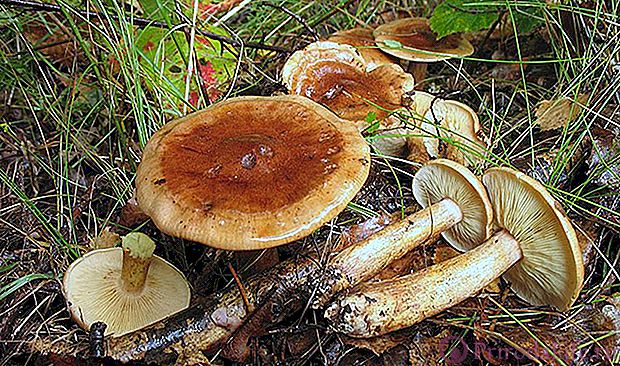 Flesh: white with a brown tint, dense, odorless, has a slight bitterness. Some sources say that the mushroom has a mealy smell.
Flesh: white with a brown tint, dense, odorless, has a slight bitterness. Some sources say that the mushroom has a mealy smell.
Blades: adherent with a tooth, frequent, white, with noticeable small reddish spots.
In this case, a preliminary heat treatment is used for 30-40 minutes to remove the bitterness.
Similarities and differences: the white-brown ryadovka is similar to the fibrous-scaly ryadovka, but the latter is distinguished by a solid scaly cap, dullness and lack of stickiness in rainy weather.
 The mushroom also has similarities with the yellow-brown ryadovka. However, the leg of the yellow-brown “sister” has a ring of thin film tissue on, as well as a slimy feeling under the cap and a bitter taste.
The mushroom also has similarities with the yellow-brown ryadovka. However, the leg of the yellow-brown “sister” has a ring of thin film tissue on, as well as a slimy feeling under the cap and a bitter taste.
Spotted row is another species that looks like a white-brown row. This is a slightly poisonous mushroom, characterized by the presence of dark spots on the surface of the cap, which are located along the edges in circles or radially. This mushroom lacks a tubercle in the center, the asymmetric curvature of the caps is strongly pronounced in old specimens, and the pulp has a bitter taste.
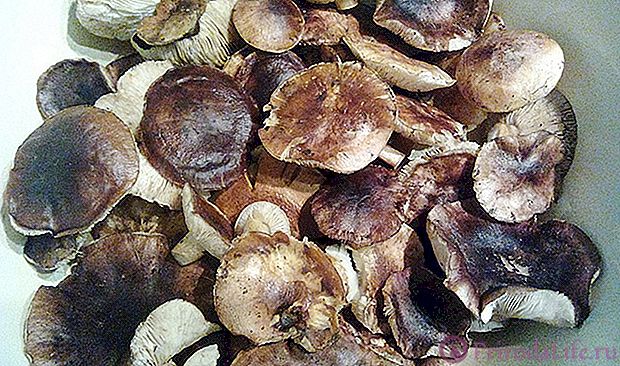 Distribution: the white-brown row or the white-brown row begins fruiting from August and continues almost until the end of October. Prefers pine or coniferous forests, less often found in mixed. It grows in small groups, forming rows, rarely found in solitary specimens. It is found throughout Russia and Europe in coniferous forests and pine forests.
Distribution: the white-brown row or the white-brown row begins fruiting from August and continues almost until the end of October. Prefers pine or coniferous forests, less often found in mixed. It grows in small groups, forming rows, rarely found in solitary specimens. It is found throughout Russia and Europe in coniferous forests and pine forests.
Distribution and fruiting period
The habitat of the yellow-brown beauty is deciduous, most often birch forests, as well as mixed and rarely conifers, of the northern temperate zone (North America, western and eastern Europe, the Urals, northern and central parts of Russia, the Far East). The fungus forms mycorrhiza with birches, sometimes with representatives of conifers.
The yellow-brown ryadovka grows most often in large groups, quite often forms "witch's circles", it is rarely found singly. The fruiting period begins at the end of August and lasts until October.
Quite often found on the way of lovers of "quiet hunting", always bears fruit actively and copes well with drought.
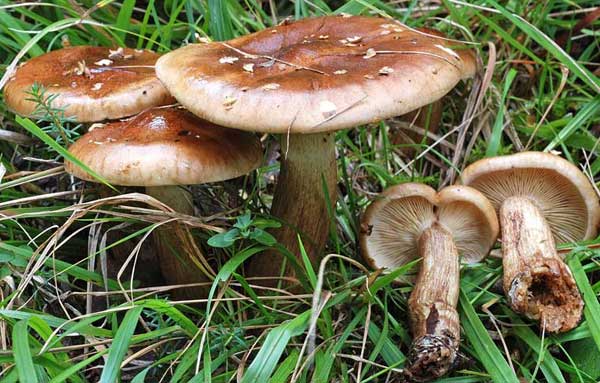
Growing places
The generic name for gray ryadovka is tricholoma. This group includes many species, among which there are poisonous and conditionally edible. Also, there are, and the second group is not toxic to humans, but does not represent nutritional value. Thus, all varieties of tricholoma are divided into 4 groups. From the point of view of botanists, ryadovka is a lamellar above-soil fungus, the genus is agaric, the family is rowovy or tricholomaceous.
The pulp of the fruiting body exudes a light fruity aroma, it tastes slightly sweet. The color can be light gray, gray-lilac, pale purple, white. Lilipopus fungi often thrive where there is a lot of ash, but they can be found in other forests, as well as in grassy steppes. In years with favorable weather, fruiting begins in mid-spring and continues until the second decade of October.
Earthy gray
The plates are wide, often located, almost white in young specimens, brownish or reddish-brown in old specimens. The pulp has a delicate aroma characteristic of edible mushrooms and has a nutty flavor. At the break, the mushroom is white, after a while the damaged area becomes light red or yellow. The colossus row forms a mycorrhizal symbiosis with pine, and is common in Russia, Japan, North Africa and some European countries. Fruiting begins in early or mid-August and continues throughout September.
Hazelnut honey
Another type of ryadovka is called walnut honey. It is known as brown, reddish brown, and yellowish brown. This mushroom is suitable for human consumption, but even after prolonged heat treatment, the pulp is slightly bitter. In young specimens, the cap is slightly convex, less often it is rounded, becoming flat with age. There is a slight bulge in the middle. In the early days, the skin is smooth and sticky, then it becomes rough and covered with scales. The cap grows up to 15 cm in diameter, is colored light brown at the edges, darker in the center, with a red tint.
This species grows only in birch forests. Fruiting peaks in August and September. Brown ryadovka has white friable flesh with a mealy taste and aroma. The plates are yellowish, can be located both rarely and often, as the fungus ages, they acquire a brown color. The leg is yellow-brown below, white on top, interspersed with brown fibers.
These are the most common edible ryadovka varieties. According to their descriptions, they can be easily distinguished from poisonous and inedible ones.
Ryadovka (Tricholoma) belongs to the genus of lamellar ground mushrooms from the family Ryadovykovy. Their hats are usually colored, hemispherical in shape. Convex, while the fruiting bodies are young, as the fungus ages, they acquire a flatter shape. The edge of the cap is wavy, usually bent or rolled outward. From above, the mushroom looks fibrous or scaly.
The leg is dense, with plates adhered to it. Occasionally there is a filmy bedspread. A faint foot ring remains from a short-lived private bedspread. The spores of the fungus are colorless, with a smooth surface. Many types of rows smell of flour, often change their external species characteristics, which makes it difficult to identify them from a photo. Edible and inedible rows grow practically throughout the territory of Russia and beyond.
Inedible types of rows
Pseudo-white (Tricholoma pseudoalbum)
- It inhabits singly or in small groups in mixed or deciduous forests.
- It grows from August to October.
- At the beginning of growth, the cap is hemispherical, later becomes convex, reaching a diameter of 3-8 cm. Its color is white, cream or slightly pinkish.
- The leg grows up to 3-9 cm in height and 1.5 cm in width.It is the same shade as the hat: white, pinkish or creamy white.
- The pulp with a mealy odor, white at first, then slightly yellowish.
- The plates are creamy, at first slightly adherent, and then almost free.
- It has an unpleasant taste, therefore it is not eaten.
This species is similar in shape and size to the May row (Tricholoma gambosa). But the latter has greenish or pale pink areas on the cap.
Smelly (Tricholoma inamoenum)
- Grows in groups or singly in moist areas of deciduous or mixed forests.
- The growing season is from June to October.
- The cap usually reaches 3-8 cm in diameter, but can grow up to 15 cm. Its surface is smooth, often bumpy, ivory or white, and as it grows, brownish or yellowish spots appear. At the beginning of growth, the cap has a hemispherical shape, and with age it is convex, with slightly wavy edges.
- The length of the leg grows up to 5-15 cm, and the thickness is up to 2 cm. It has a cylindrical shape, elastic and dense, the color is identical to the cap.
- The flesh is white, fleshy and firm. The representatives of this species are distinguished by a strong smelly odor, which is inherent in both young and old mushrooms. The smell is similar to light gas.
- The adherent mid-frequency plates can be white or cream in color.
- Because of the stench, these mushrooms are not edible. Even cooking does not eliminate it.
Often, at the beginning of growth, you can confuse the smelly ryadovka with edible sulfur (Tricholoma portentosum). But it lives up to the name and the smelly smell is hard to miss. And the gray ryadovka has a pleasant mushroom aroma.
Feature and Description
Like other caps of pedunculated mushrooms, the body of the row consists of a stem and a cap. Both parts are capable of taking different forms, and their shades often vary. The upper part of the young row is in the form of a ball, cone, bell or flattened hemisphere. The size of the cap in diameter in young mushrooms is 3-4 cm, in adults - 15-20 m or more.
The older the mushroom, the flatter its cap becomes. At the edges, it can be either flat or bent inward or outward. Sometimes a slight bulge remains in the center, but some species do not. The mushroom has a skin that peels off in thin strips when pulled. The surface of the cap can be:
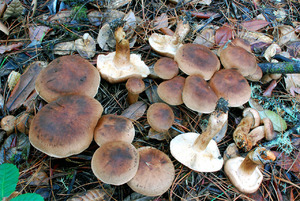
The row forms a leg with a height of 3-10 cm.In a young mushroom it has a thickness of 0.7-0.8 cm, in an old one it reaches 2.3 cm.Sometimes the leg grows the same over its entire height, but it also happens that it narrows or expands up. There are also mushrooms with clavate bases.
The color of the flesh of the leg is usually brownish, gray-pink or pink-brown, but only in the middle and lower part. Under the cap itself, there is a small area that is lighter than the rest of the mushroom. In some subspecies, a protective ring is located in the same place - what remains of the fibrous cover that covers the plates. The surface of the leg is velvety, covered with scales (which makes it appear fluffy), fibrous or completely smooth.
Description of the pigeon row and differences from the white variety
Latin name:
Tricholoma columbetta.
Family:
Ordinary.
Synonyms:
the row is bluish.
Hat:
hemispherical or bell-shaped, fleshy, in diameter it can reach up to 12 cm. As it grows up, the cap opens and becomes flat, and its edges are bent down. A small bump can often be seen in the center. The surface is sticky, in young specimens it is radial-fibrous with the presence of light scales. The color of the cap is white, sometimes with pinkish or bluish spots.
Leg:
height up to 10 cm, thickness up to 3 cm, round, flat or tapering downward. The surface is silky, smooth, fibrous, dense inside. The color of the stem at the ryadovka is bluish white, and a slight bluish-green tint is noticeable at the base.
Pulp:
elastic, dense, fleshy, white in color. The smell and taste are pleasant, but subtle. Upon contact with air, the pulp of the mushroom becomes pink, and under the influence of high temperature it turns red.
Plates:
free, wide, frequent, at a young age white, and over time acquire a reddish-brown color.
Edibility:
edible mushroom.
Application:
suitable for preparing various dishes and preparations for the winter. The pigeon row is good in soups and sauces. She perfectly decorates the festive table in the form of a pickled or salty snack. The fruiting body is also dried for long-term storage. Many experienced mushroom pickers note that this mushroom gives a unique aroma to meat dishes. However, before cooking, it must be soaked in cold water and then boiled for at least 15 minutes. Both young and adult specimens are used for food. In addition, even those fruit bodies that have survived the first frosts are suitable for processing. Such gustatory qualities induce beginner lovers of "quiet hunting" by all means to study the description and photo of the pigeon ryadovka mushroom, so as not to lose sight of it in the forest.


Similarities and differences:
this species is similar to the white ryadovka (Tricholoma album) - a dangerous poisonous mushroom. However, the differences between the pigeon ryadovka and the white variety are quite simple to notice. From the latter comes a sharp disgusting smell, which helps to determine the edibility of the mushroom.
Spreading:
the bluish ryadovka is a rather rare species in its family. The mushroom grows mainly in mixed and deciduous forests. Most often it can be seen near birches and oaks. Sometimes it can settle in pastures and meadows. Grows singly or in small groups from August to September.
Systematics:
- Department: Basidiomycota (Basidiomycetes)
- Subdivision: Agaricomycotina
- Class: Agaricomycetes
- Subclass: Agaricomycetidae
- Order: Agaricales (Agaric or Lamellar)
- Family: Tricholomataceae (Tricholomaceae or Ordinary)
- Genus: Tricholoma (Tricholoma or Ryadovka)
- View: Tricholoma columbetta (Pigeon line)
Row glaucous
(lat. Tricholoma columbetta
) is a fungus belonging to the Ryadovkov family. The family includes more than one hundred growing mushroom species. The pigeon row is edible and belongs to the genus of hat plate mushrooms. Mushroom pickers rarely come across.
The mushroom is decorated with a large fleshy cap measuring twelve centimeters in diameter. The hemispherical cap of the mushroom opens as it grows, and its ends are bent down. In young mushrooms, the light surface of the cap is covered with scales that match the general color of the mushroom.
The thick, dense pulp of the mushroom becomes pinkish at the fracture. It has a weak taste and smell. The tall, powerful mushroom stem has a dense fibrous structure.
Row pigeon grows singly or in small groups from mid-August to late September in mixed forests. Likes to settle next to oak and birch. Mushroom pickers noticed cases of its growth not only in the forest, but also in meadows and pastures.
This mushroom is used in a wide variety of prepared dishes. A wide variety of soups and sauces are prepared from it. The ryadovka can be grilled and dried for future use, and is also suitable for decorating festive dishes. The ryadovka cooked with meat gives the dish an extraordinary aroma. Among professional culinary experts, it is considered a very tasty mushroom with a peculiar pleasant aroma.
Before cooking, the mushroom is soaked in cold water, after which the skin is removed from its cap. Then a 15-minute thermal treatment is carried out. The row is suitable for harvesting for the winter in salted or pickled form. For cooking, both young and adult mushrooms, as well as the first frosts that have been frozen, are suitable.

